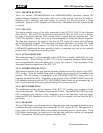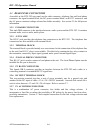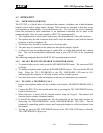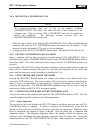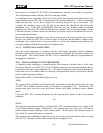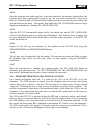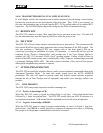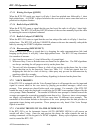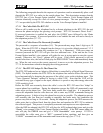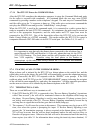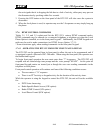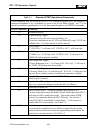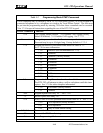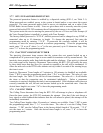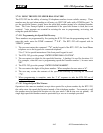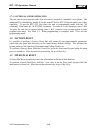
RTU-292 Operations Manual
The following paragraphs describe the sequence of operations used to automatically place a call
through the RTU-292 to a radio via the outside phone line. This description assumes that the
RTU-292 has a Voice Prompt Option installed. Units without a Voice Prompt Option will
function identically except for a lack of voice prompt messages. The tone prompts listed in
3.7.1 are provided by the RTU-292 whether or not the Voice Prompt Option is installed.
3.7.3.1 The Caller Dials The RTU-292
When a call is made over the telephone line by a distant telephone to the RTU-292, the unit
answers the phone and plays the greeting voice prompt: “RTU-292 Automatic Phone Patch”.
If password protection is enabled the unit plays the QUERY tones followed by the “
Enter
Password
” voice prompt. If password protection is not enabled the unit will move directly to
the adaptation process (3.7.3.3).
3.7.3.2 The Caller Enters The Password (if enabled)
The password is a sequence of numbers (0-9). The password may range from 1 digit up to 10
digits. When the RTU-292 is shipped from the factory it is given the default password “1 2 3
4”. The password may contain only numbers (no * or # characters). If the user enters an
incorrect password the RTU-292 will give him two additional tries. If the unit has the Voice
Prompt Option installed, voice prompts will guide the user in trying again to enter the correct
prompt. Otherwise, the “Query” prompt will be given. If the correct password is still not
entered after three tries, the unit will then play the DISCONNECT tones and immediately hang
up. When the unit receives the correct password, it moves on to the adaptation process. See
3.7.3.4 for instructions related to changing the existing password.
3.7.3.3 The RTU-292 Adapts To The Phone Line
The RTU-292 hardware has an Adaptive Hybrid that is controlled by a Digital Signal Processor
(DSP). The hybrid matches the RTU-292 to the telephone line and also allows the radio to be
keyed automatically by detecting the presence of the caller's voice on the telephone input. This
“Voice Operated Transmit” method of keying is called VOX. Note that the VOX will be
activated for any type of signal on the input, whether it is speech or any other energy above the
VOX sensitivity level.
Before the DSP can accurately detect the caller's voice the RTU-292 must first "adapt" to
current phone line conditions. During the adaptation process the DSP will momentarily emit
white noise on the phone line. This noise burst sounds like a loud hiss. It is important for
successful adaptation that the caller does not talk or enter any DTMF commands during the
adaptation process. It helps to keep the phone line as quiet as possible. The adaptation process
will normally take less than two seconds to complete, but under noisy line conditions the
process may take as long as 10 seconds. During the adaptation process, the DSP measures the
white noise that is reflected back from the phone line and matches the RTU-292 to minimize
the reflected signal. This process is completely automatic and requires no user adjustments.
After the DSP has adapted, the RTU-292 will play the ACK (acknowledge) tones and give the
“
Ready” voice prompt (if the Voice Prompt Option is installed). If the DSP cannot adapt, the
unit will play the ERROR tone and give a “
VOX Unavailable” voice prompt. If VOX is
unavailable the caller must give a “KEY” command before speaking, and then give an
“UNKEY” command turn off the transmitter and listen to the reply (see 3.7.3.4).
JPS Communications, Inc.
3-11



